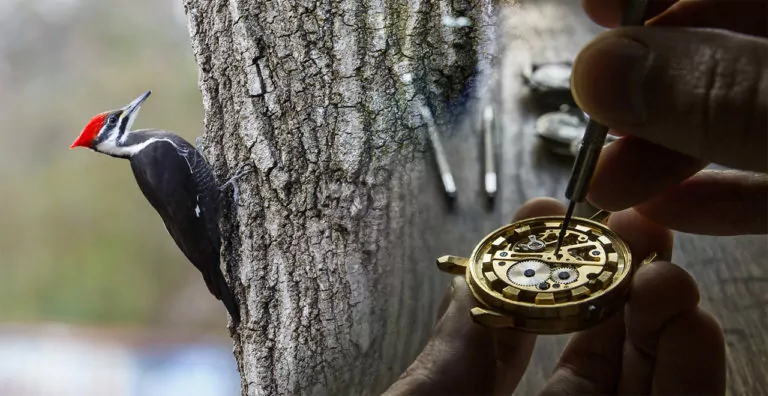Two hundred years ago a bishop, by the name of William Paley, wrote a book in which he used a watch to illustrate how clear it was that God is real. He pointed out how many intricate parts a watch had; and how only a skilled watchmaker could put these parts together. He described how the watch was designed so that each small part had a purpose. He then argued that the watch, because it had so many parts, had to have a planner and that, because the watch had a purpose – to tell time – it had to be an intelligent planner.
And then Bishop Paley also pointed out that there were many creatures much more complex and wonderful than the watch.
Consider the woodpecker
One of these creatures is the woodpecker — a bright, feathered hammerhead, whom we often nickname Woody. And if we look at the complex, awesome parts of the woodpecker, we cannot help but stand in awe of our Creator.
1. Shock-absorbing beak
The woodpecker, is a marvelous bird and far from ordinary. Take his bill, for example. Isn’t it amazing how he can ram it into a tree thousands of times a minute without having to replace it or getting a terrific headache? Well, his head is equipped with shock absorbers. And these shock absorbers cushion the blows so that the skull and brain of the woodpecker do not suffer.
2. Feet that grip
Now consider his feet. Have you ever wondered how this bird could stand sideways against the tree for such a long time without slipping off? Well, God equipped the woodpecker with very stiff tail feathers with which he can brace himself. Also, his feet have four claw-like toes. Two toes point up and two point down — so that he can get a good grip on bark.
3. Glue the grips
Now, once he’s drilled his little hole, how does he manage to reach inside the tree for his supper? Again, our God and his Creator has equipped him well. The woodpecker has a wonderful tongue. It’s long, with special glands on it which secrete a substance that bugs stick to like glue. When the woodpecker pulls his tongue out of the drilled hole it’s covered with a smorgasbord of insects.
4. Tongue that curls
The woodpecker’s tongue is worth even closer scrutiny. Most birds have tongues that are fastened to the back of their beak. The woodpecker would choke if this was the case because his tongue is far too long. So do you know where God fastened it? In his right nostril. Yes, when the woodpecker is not using his tongue, he rolls it up and stores it in his nose. Coming from the right nostril, the tongue divides into two halves. Each half passes over each side of the skull, (under the skin), comes around and up underneath the beak and enters the beak through a hole. And at this point the two halves combine and come out of his mouth. You have to agree that the woodpecker’s tongue is a most intricate and complicated piece of equipment.
Blind to the wonder
Not everyone believes that God created “every winged bird according to its kind.” (Genesis 1:21b) Some evolutionists believe that birds were first reptiles. A 1980 Science Yearbook states that
“paleontologists assume that the bird’s ancestors learned to climb trees to escape from predators and to seek insect food. Once the ‘bird’ was in a tree, feathers and wings evolved (grew) to aid in guiding from branch to branch.”
Isn’t it funny to think of so-called scientific men who believe this? If evolution were really true, why don’t we see lizards sitting in trees today sprouting little feathers? Doesn’t the thought alone make you chuckle? Actually, some evolutionists themselves are even aware that this is not really true. In 1985 an evolutionist named Feduccia said, “Feathers are features unique to birds, and there are no known intermediate structures between reptilian scales and feather.”
So why do people continue to believe and teach evolution? Romans 1:18-20 tells us why. Some people choose to suppress the truth. They have no faith in God’s marvelous creation, even though it is all around them, and these people are “without excuse” (v. 20) before God.
No, we are wise to stick to our faith in Scripture. The complexity of birds, certainly including the woodpecker, point to an intelligent Creator. And Bishop Paley’s argument is good because today, 200 years later, we can point to many other living creatures also, (even tiny microscopic forms of life are infinitely complex), who could never have come about by any chance process of evolution. We praise and thank God for His marvelous creation. With the four and twenty elders of Revelations 4:11 we can say:
“You are worthy, our Lord and God, to receive glory and honor and power, for You created all things, and by Your will they were created and have their being.”
Christine Farenhorst is the author of many books, including her new historical fiction novel, Katharina, Katharina, about the times of Martin Luther. This article first appeared in the February 1991 issue of Reformed Perspective.











